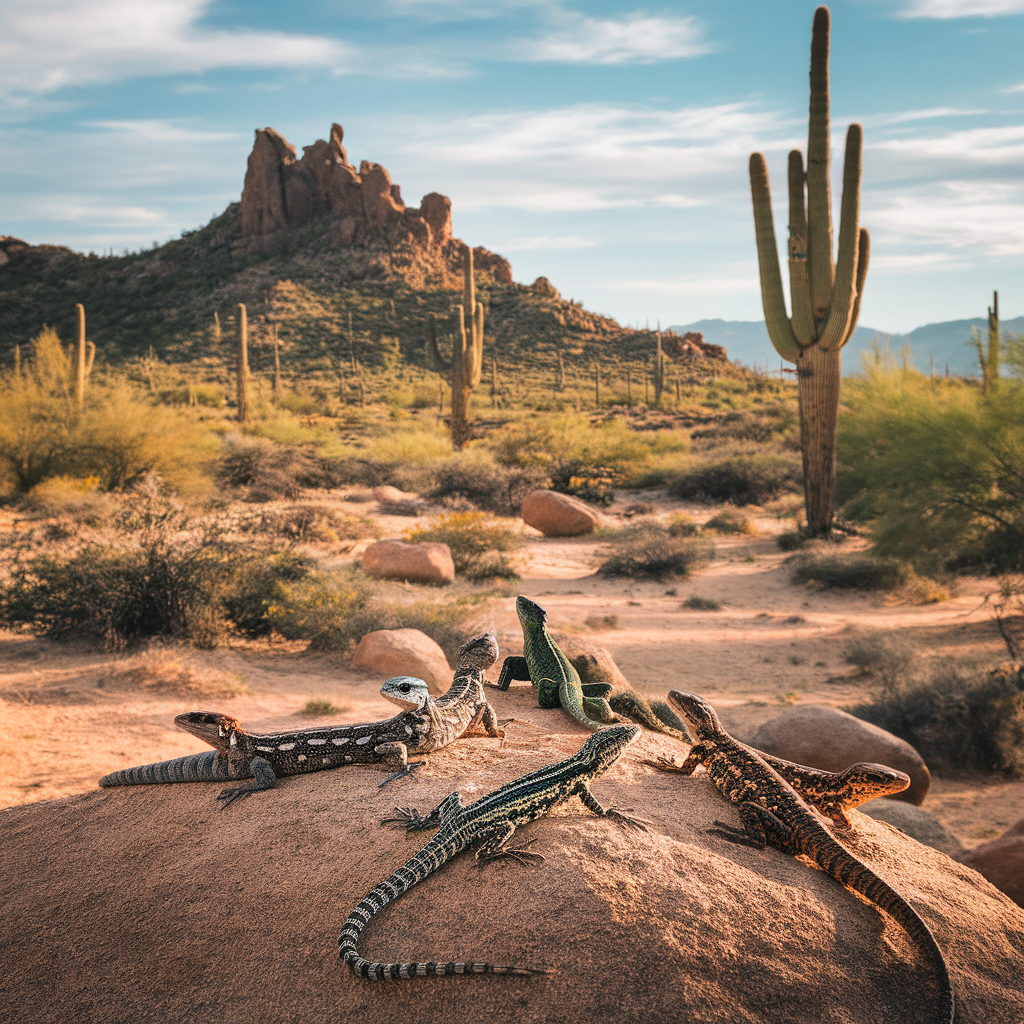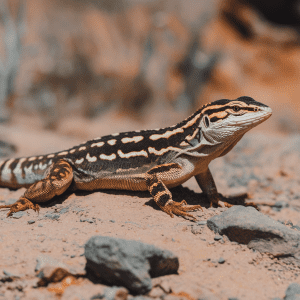Have you ever stared at your pet lizard, exchanging blank faces… or maybe tail swishes, contemplating what’s going on in their little lizard brains? Or perhaps questioned the possibilities of a family road trip without leaving your scaly friend behind? Well, you're not alone! Welcome to the exciting world where 'herpetoculture' meets adventure. Imagine understanding your lizard so well that you can help it adjust to different environments—a valuable skill not just when moving house, but also when taking rejuvenating family trips. Yes, we're talking about seamlessly blending travel – from brief jaunts to the park to adventurous quests abroad – with your cherished reptile-keeping hobby. It may sound a bit challenging (or exotic!), given the unique nature of these beautiful creatures and our lack of in-depth understanding about them. But hey, every grand journey starts with baby steps, right? At this very junction, while navigating the intriguing labyrinth of lizard training, it’s affirmatively normal to feel like a small fish in a big pond – the 'Lack-of-Knowledge Pond.' Let’s face it! Reptiles don’t exactly come with instruction manuals, do they? What if I told you that these challenges can be turned into meaningful experiences of bonding with your scaly companion, foolproofing your vacation plans? No hocus-pocus, just real, practical lizard training tips! Included within this comprehensive guide are insights amassed from seasoned pros and illuminated pathfinders who've turned rookie reptile parents into bona fide lizard whisperers. In sharing this valuable knowledge, our intention is complete transparency and openness. By journey's end, we aim to not only demystify the complex world of lizard linguistics and transitioning to various environments but also offer savvy ways to incorporate travel involvement into their lifestyle. But don’t worry; this isn't a dry academic thesis nor a quick-fix manual with dubious guarantees. Weaving through practical advice, coupled with relatable stories and a hint of humor, this guide aims to equip you with tested lizard training tips and preemptive measures against common missteps. So, strap yourselves in. Let’s take a 'leap(rectile) of faith' together, making strides to change the perception of reptile parenting into a fulfilling & adventurous passion—keeping transparency at its core. Talk about a family-friendly lizard escapade… literally!
"Diving Into the Basics: Understanding the World of Lizard Training"
Embarking on family travel can often be synonymous with discovering new experiences, and what's more interesting than a surprising addition of a “travel-lizard” in the mix? Take a moment to incline your minds towards the extraordinary, yet plausible concept of trained lizards partaking in your travel escapades. Haven’t done it before? No sweat! This introductory portion hones in on the fundamentals by providing you with effective lizard training tips to get you started. Lizards are known creatures of routine, endowing them with the unrivaled ability to master fundamental trainings. Watching your children engage with a friendly trained lizard in a safe manner can open their minds to much-needed respect for nature, paired with a unique sense of responsibility and thrill. Your kids' scientific lunch box stories or summer camp yawns will become more intriguing! Training a lizard is not rocket science; it just necessitates respect for their natural behaviour while introducing regulated habits gradually. Warm them up with consistent feeding times within familiar surroundings followed by supervised exposure to new ones. For example, making their feeding time in sync with your morning coffee routine creates an alignment of schedules that helps them adjust better. But remember, openness and transparency are quintessential—commonly known real titan lizard can be trained but an ornate monitor lizard can't—no training can defy nature's call. On this exciting journey, patience is your greatest companion. Rushing the process won’t yield results. Expressing love and care to gently coax these amusing creatures into performing desired actions takes time, but ending up with a genial travel partner makes it worthwhile. Once you have established clear routines and bridged the hurdle of unresponsiveness or fear, introduce simple commands. Use words like "up" in an encouraging tone when you want them to climb over an object. So, when you reunite over camping around a mountain top, that confidence-building 'up' might help them climb and perch, creating memorable seaside scenes. Now you are packing more than just a picnic basket, aren't you? With this approach towards lizard training, you're fostering incredible family experiences which transcend the ordinary. More than mere sightseeing, you have created a fabric of lasting memories interwoven with your travel adventure—a sure shot way to build brand authority in your space while delighting young observers along the way. So here's to your exciting, educative travel journey with your scaled companion aiding your children's fascination for wildlife. Dive into exploring these lizard training tips, enlighten your surrounding parenting communities about your endeavor and watch as you trailblaze a pet-friendly approach to travel that is novel. So what’s your first training story going to be? A summer camping hike or a beach barbeque? The real joy is in accomplishing the unknown. Enjoy the journey and happy travels!
"Tips and Tricks for Transitioning Your Lizard to a New Environment"
If there's one thing we, as parents and families, understand intuitively—its transitions. We've maneuvered job changes, school shifts, and even the tumultuous voyage from adolescence to adulthood. Now, in our journey of pursuing our passions for travel, we've welcomed a new challenge: helping our reptilian friends adjust to new environments! Incorporating our beloved lizards as we hop between different travel destinations can be an exciting new endeavor. However, if you’re worrying about lack of knowledge or expertise, we’ve got your back! Armed with a few simple lizard training tips, you'll enjoy this bonding experience and claim your family's place among amateur herpetologists. Our first stop on this venture reminds us that lizards are creatures of habit and familiarity. To kick-start this transition efficiently, make a replica of their current habitat in the new environment. Duplicate the elements such as the type, location, and strength of heat and lighting sources, hiding spots, plants or decor items will help your lizard feel more at home. Next station—acclimatizing your lizard to the new space even before moving them. Gradually introduce objects or sand from the new habitat into your pet's current environment. This method promotes familiarity with the sights and smells of the new surroundings while instilling comfort. Another gem among reptile training tips lies within schedules. Lizards are quite fond of routines; hence it is recommended to maintain your pet’s usual feeding, handling, and light-cycle timetable even during the transition period. For instance, if you usually feed your Bearded Dragon at 10 AM while at home, continue doing so while traveling. Also remember—priority should be your pet's comfort during transportation to limit stress as much as possible. Did we ever prepare ourselves for middle school or college by suddenly appearing on the first day? Of course not! It's all about taking steps right? So follow these advances within the scope of lizard training tips – expose your lizard to short bouts in the new setup, a few hours at a time. Last but not least, keep an eye on your companion. Be patient, as your pet might take time to adjust. Look for signs of normal activity such as basking, burrowing, or feeding to ensure they’re getting comfortable. It may be a learning curve, navigating all these shifting landscapes with our lizard pals—but then again, change always is. Embrace the challenge with openness and patience and enjoy the incredible journey—Because forging bonds with a new member of the traveler’s group is not just about building brand authority—it's about embodying our core values of transparency and being open to these extraordinary experiences. Within us all are reptile wrangling naturalists—unleashing those innate abilities can be easier than we might have anticipated. Happy travels, and happier transitions! To hit the road of expertise in reptilian care during travels, check our other sections on various lizard training tips and make your travel journey even more exciting!
"Let's Chat About Communication: Demystifying Lizard Training Linguistics"

Building on the exciting world of lizard ownership we've explored so far, you might be prepared physically with a flawless setup. However, how equipped are you to ‘speak lizard’? As the continuation of our commitment to transparency and openness, we'll navigate the mesmerizing 'Lizard Training Linguistics'. That's right—communication is a critical part of lizard training tips. A knowledge gap is typical here, but rest assured, we've got your back. Think about it. Wouldn't it be wonderful if vacations involving long hours of travel didn't have to mean missing out on bonding moments with your scaley friends? Families across the globe want to bring their pet lizards along for their wanderlust adventures. But fear not! With simple lizard linguistic skills, your lovable critter could be the next great travel companion! There is no secret hand gesture or magic spell for this process—it’s all about monitoring and understanding. Observe: lizards speak through their behavior, posture, and glaring color changes in some species—signs that are often magnificent but also potentially daunting to decipher. Soaking these signals up is imperative and allows you to respond appropriately to your pet's needs. These actions collectively form our "Lizard Training Tips". Once familiar with the lizard language, next is mastering your responses, typically 'postural-feedback'. Does your bearded dragon puff out his beard often? Acknowledge that! Respond to this assertive sign with a non-threatening posture—slight tilting of your head away. You're saying, "I'm not your rival, buddy!" Modal dialogues just like this form a big part of "Lizard Training Linguistics". Incorporating them into your routines deepens inter-species relations, significantly amplifies your family stories from those holiday road trips, and makes care-giving a structured rather than stressful part of traveling with family—all critical for building brand authority in travel adaptations. Subtle is the order of the day when it comes to training lizards. Try to understand their displacement reactions—slight looking away, or literally, slithering away—which can be seen as retreats from explicit stimuli, even your benign petting attempts. This is perfectly normal among creatures that spent eons avoiding larger predators. Taking 'no' for an answer is an amazing lesson in the lizard language curriculum and an unequivocal act of love. By reducing the lizard’s stress in novel environments like getaways lodgings, it makes them reliable travelers. Remember training is an ongoing conversation that doesn't have to stop midway just because there's a flight to catch. Respect for their space reaffirms the unique bond you share and emphasizes a home-style environment even during travel. More tales around the bonfire? Yes, please! In understanding "Lizard Training Linguistics", you eventually depict their needs about the love they are capable of receiving and rekindling. No wonder parents and families increasingly champion these practices during their journeys. When it comes to pets adapting to travel, your accounts could inspire more to follow down this rewarding path! An amazing travel-blog entry waiting to happen, wouldn't you agree? Your scaley sidekick might not understand the memoir you're creating around them, but every nod, every tilt towards them—interwoven with the release of those fears brought about by journeys unknown—are all notes on an octave that sings just one song: "Travel need not lose its charm; we just have to learn our friend's tact." So dabble fearlessly into deciphering your pet lizard’s language. Exploring "Lizard Training Linguistics" along your travels might just open up beautiful avenues of companionship you never thought possible. After all, family vacations are for all members of the family—whether human or adorably reptilian.
"From Local Parks to Exotic Destinations: Integrating Travel into Your Lizard Training Regime"
Have you ever wondered if you could amp up your lizard training by adding a little jet-setting adventure to the mix? Good news: you absolutely can. In fact, integrating travel into your lizard training regimen not only makes for unforgettable family experiences but also helps your scaly friends become more confident and adaptable. Now, we understand it can get a bit intimidating–especially if you're a novice in lizard parenting or a newbie to the whirlwind world of travel. But fear not! In perfect harmony with our transparency and openness mantra, we have put together some life-altering "Lizard Training Tips" that make traversing the globe with your reptile as easy (and fun!) as an afternoon at your local park. Let's all remember, exploration is not just for humans and dogs; lizards too enjoy a change of scenery! Starting small is a golden rule here. Begin by taking your lizard to nearby parks or local recreation spots. This familiarizes your pet with changing environments and bustling noises without being too overbearing. Besides, the experience will come in handy when navigating through vibrant food markets in Thailand or exploring lush rainforests in Costa Rica. Wondering how park visits translate into lizard training victories? The different sensory experiences — new smells, sounds, and sights — challenge your lizard’s adaptability. This is an advanced form of lizard training often called "environmental variance" training. You might even want to bring a blanket or basket so they might safely observe their surroundings—an excellent bonding opportunity! Incrementally lengthening the duration of outings slowly adapting them to longer excursions, says our insider "Lizard Training Tips". While this gets them used to being away from home for extended periods, it also serves to finesse their travel etiquette before embarking on more adventurous trips. By this point, you've had several successful park sojourns with your tiny companion. You may be asking yourself, "Am I ready for a family vacation now?" We say, rally the troops and start packing, but consider choosing destinations where lizards can flourish. Tropical locales or areas with reptile-friendly attractions, like Florida's Everglades, Mexico's Mayan Ruins, or Australia's Gondwana Rainforests top our list. Never forget that exercising caution and vigilance is paramount. Familiarize yourself with local regulations about bringing pets and always keep them in supervised, secure enclosures. Also, pack all essentials – heat lamps, lizard-approved sunblock (yes, they exist!), quality food, portable water dispenser – in a travel-savvy way; there will be plenty of "Lizard Training Tips" on this subject in our next section. Showing off your well-travelled, well-mannered lizard surely boosts your brand authority among fellow pet enthusiasts. As you share your globe-trotting experiences and pertinent lizard training tips on social media or in reptile forums, you're not merely flaunting a well-executed training regimen; you're sharing a noticeable commitment to your lizard’s well-being. Your actions create consequently a domino effect within the pet-owning communities – eventually encouraging others to consider integrating travel into their lizard training regimes—thereby facilitating a transformative change. So, as the parable famously states – the journey of a thousand miles begins with a single park visit – or something like that! Ready to embark on this thrilling voyage from local parks to exotic destinations? Your lizard can't wait to plunge into these exciting adventures along with you!
"Navigating Common Missteps: Preventive Guidelines for Your Lizard Training Path"
Treating yourself to a new pet while vacationing isn't always as quiet as lazy afternoons with a cereal bowl-sized turtle. Lizard training can stir up family fun, sprout giggles, and yes, sometimes prompt a gasp or two. Fear not: every budding herpetologist occasionally stumbles along the path, and you're not alone in your thirst for lizard training tips. Visiting exotic locales often inspires us to bring back unique mementos—the chameleon your son fell in love with at the resort pet shop, for instance. Even a jaw-dropping, scaly souvenir doesn't have to be a recipe for mishaps, though. Knowledge gaps can be bridged. With the right guidance, you'll morph into a lizard whisperer in no time. One common hiccup families face involves insufficient habitat set-up. Lizards need space, warmth, and light set just right — it's their factory-equipped love for sunshine that burrows them deep into our hearts. Make sure that the vivarium mimics the creature's natural environment—tropical lizards need high humidity levels; desert dwellers want sandy terrains. Another barrier worth bracing for— lizards can sometimes come with an attitude or the lack thereof. Deliver handling sessions short but sweet until your scaled friend establishes trust. Remember, slow-touch and calm-voices will pave this path of adjunction assertion. Just like human wanderlust that got you this far down the reptile road let your lizard off the leash, quite literally. While many vacation guides promote the joy of discovery, creatures of habit like our cold-blooded compadres don't much fancy fluctuating schedules and diets, especially on the road. Sticking to a familiar feeding schedule and diet will make your lizard feel at home. Too much hand-holding can be another runaway rolling suitcase of overzealous keepers. Jumping in to help your lizard shed, for example, can stress them out. Let nature take its course. Remember that being there when needed is caring but responsiveness is better than interference. Practice these guidelines with confidence fundamental to being a reliable source of knowledge for your young ones. This family outing isn't just another pin in your world map – it's an opportunity. Untangle the seemingly knotty thread of lizard training tips, guesswork replaced by expertise. It's a chance to do more than just claim space on the internet; it's an open invitation to begin building your familial brand authority. Above all else, transparency sweeps eons ahead of sugar-coating any care-taking truth. Full view, no surprises—that’s our way of life. Just like the clarity of shimmering beach waves meeting peaceful seashores, our love for openness transcends squiggles on pages. We aren’t just building sandcastles in the sunshine here—we’re making them ghost-crab proof. And who knows? Someday, some parent might walk down their memory lane, and your highly practiced tips and heart-warming shared experiences become someone else's passed-on tradition. In the end, be willing to embrace both winning wanders and fumbling falls on this journey — because every mishap you dodge, and almost every challenge overcome helps make next time better; building our shared knowledge like pebbles collected along the sea coast.
Conclusion
Embrace the Adventure: Taking Your First Steps in Lizard Training There you have it, future lizard whisperers! We've gallivanted through the intricacies of lizard lingo and nuzzled into newbie slip-ups, ready to turn them into victories. Now is the time to use these "Lizard Training Tips" to begin a unique adventure alongside your scaly buddies. Parents and families out there, we see you. This guide, brimful of holistic knowledge about 'how-to's and 'what-not's, was created with special consideration for those confronting the challenge of the unknown. The anxiety that stems from paddling through an unknown territory is real and recognized. Remember, possession of knowledge erupts confidence, and there’s nothing standing between you and that triumph, except the bravery to start. Don’t forget, this should be a joy ride! Take some time out and incorporate tiny steps of starting your lizard training in your next family holiday. You've got this! There is truly something magical about being able to integrate the thrill of travel into your progress as a lizard trainer. Parks, deserts, jungle safaris, or tranquil beaches – every corner of our amazing planet has something to teach us and our spirited pet lizards. Just think of this spectacular overflow of ‘Lizard Training Tips’ as your guiding star, guaranteed to transform uncertainties into smiles and spark lightbulb moments at each stage of this dazzling expedition called ‘life.’ Our commitment to transparency and openness means we’ve shared essential techniques and tips from the ground up – perfect for those starting out on this surprising expedition. Let’s sum up, friends! It isn't just about starting today; it's about sustaining the entire journey with grace, grit, and good humor. Whether you're just planning or already running marathons on this track, remember each small formation in this guide was crafted with love to empower YOU to emerge as a luminary in the universe of lizard training. Now, let’s ink this day in your memory! Today, you are not just stepping into the riveting world of lizard training, but opening doors of laughter, caretaking, bonding and quintessential experiences for your family. Stick with us on this ride, following our handy guide of Lizard Training Tips. Remember dear reader, the winds of wisdom are blowing your side, how about gently spreading those sails? It's time to grab hold of hope, take off on an extraordinary journey and shimmer like a star in the vast sky of knowledge. You’re sure to remain on course navigating towards a brighter, more enlightened tomorrow. So, get ready to don the trainer’s hat and start your unique lizard training journey today! You have the power to turn these blank pages into a story of resilience, love, growth, and adventure. Let’s usher in an era of enlightenment under the scorching sun—surrounded by reptiles!



